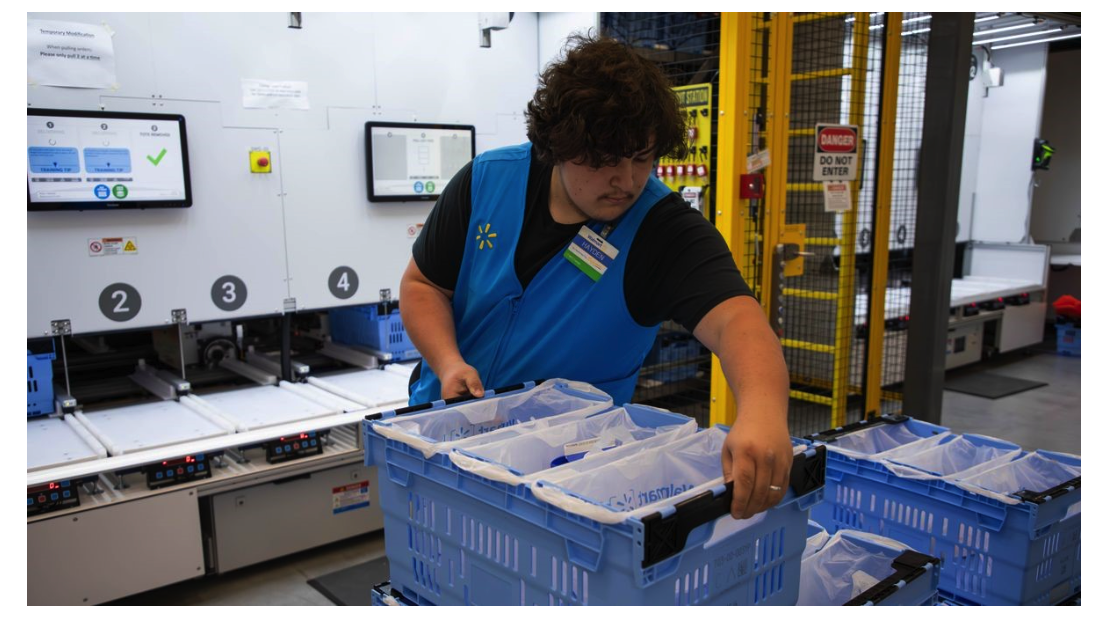As the largest retailers evolve, so does the rest of the industry.
Look no further than the popularity of retail media networks (as an example, launched by Target in 2016 and re-branded in 2019 ) or Giant Eagle as of late.
Could automated store-based micro fulfillment centers (MFCs) be next? Walmart’s recent moves in the space between the acquisition of Alert Innovations, and now the launch of a new automated fulfillment center attached to one of its stores in Bentonville, may be an early indicator of where the industry is headed.
During the pandemic, retailers launched curbside pickup and Buy Online Pickup In Stores (BOPIS) en masse to meet the demands of customers who sought the convenience, safety, and speed of shopping through these order fulfillment methods.
Now, digital ordering has become ingrained in customers’ purchasing behavior – particularly in more frequently shopped categories, such as grocery – resulting in steady digital order volume growth for many retailers along with a shift to a more store-based fulfillment network to provide greater order speeds for customers.
Given these developments, could Walmart’s move signal a broader industry shift towards increased automation in store-based fulfillment networks?
We look at a few factors to determine where the market might be headed.
Increased digital order fulfillment capacity for stores increases sales
One of the biggest challenges that automated MFCs address is increasing order capacity, not just for sites in general, but for stores in particular, as evidenced by Walmart’s strategy.

As customers’ digital order demand becomes a constant, and expectations around service speed increase, stores often strain to keep up with digital order demand. This dynamic tends to occur at the point where 20% of the store’s sales occur through digital ordering.
At this threshold, it becomes difficult for stores to pick orders from shelves to meet order promise times, and keep store shelves restocked, without detracting from the in-store experience for customers that shop in-person.
MFCs solve this problem by providing greater digital order fulfillment capacity for a store – and thus more sales/inventory throughput – through faster picking of orders and improved inventory visibility. Furthermore, MFCs allow for inventory to be pulled from a dedicated area rather than the store shelves which enhances the in-store customer experience while reducing the need to continuously restock shelves when inventory is being quickly pulled for digital orders.
Increased digital order fulfillment capacity – and speed – through the implementation of an MFC at stores that are experiencing high digital penetration increases sales by giving the store the tools to meet higher digital order volume while having the ancillary benefit of improving the experience (and inventory availability) for shoppers in-store indirectly leading to improved brick-and-mortar sales at the store as well.
Increasing fulfillment capacity through MFCs at stores with high digital order demand is the foundation for any business case related to spending several million dollars on an automation system at a specific site.
Immediate opportunity: retailers with broad assortment of SKUs and high number of units in digital orders
The most immediate opportunity for automated MFCs arises in retail stores with many SKUs – over 5000 – and where customer orders include a diverse range of these SKUs.
In general, store based MFCs lend themselves well to general merchandise models, grocery, and extend into categories like home improvement (depending on the item’s size) or department stores.
(Of course, automated MFC in a warehouse tend to make more sense for many other retailers given they house many SKUs and have high order throughput but, for now, we’ll focus on stores since many retailers are shifting more fulfillment to store-based models).
The number of SKUs offered and average order size (by unit count) matter to the business case for an automated MFC because the number of SKUs offered, and average order size contribute to the complexity (and cost) of picking orders and constraints on order promise times.
Consider the case of apparel. It’s easier to scale manual order picking with an average order size of 3-4 items from an assortment of 1,000 items in a 3,000-foot store. This contrasts with the complexity and time it takes to fulfill grocery orders with 30 items – and multiple temperature zones – in an 80,000 foot store with 40,000 SKUs.

As a result, automated MFCs lend themselves well as solutions for store-based locations that offer a broad assortment and experience high digital order volume to meet customer order demand along with expectations on order speed.
Fulfillment automation: a tradeoff between higher upfront investment (CapEx) and steady state higher variable costs (OpEx); MFCs will create greater disparity in retailers’ fulfillment capabilities
Investments in automated order fulfillment are the classic case of upfront investments to reduce variable costs over the long run.
Not every retailer can afford to invest in automation or has the digital order volume at a critical mass of stores to justify the investment. This dynamic will exacerbate the variance in digital order capabilities between retailers today and benefit the largest ones with the volume – and capital – to make the investments in MFCs.
As retailers offer faster fulfillment speeds – and customers place more digital orders every year – the gap in fulfillment network capabilities will grow in favor of retailers that invest in automation. Increased order capacity at store locations coupled with lower costs to fulfill those orders will drive a virtuous cycle for retailers that invest in automation.

Labor challenges, such as worker shortages in various regions, coupled with escalating wages, suggest that the expenses associated with efficient and timely order fulfillment are likely to rise in the future. Retailers that make investments in automation will find themselves better protected against this trend in fulfillment operations, as they will require fewer human interventions. As a result, they can then redirect their store associates to cater to customers in areas like service counters, enhancing overall customer service.
So, what does this mean for retailers in the coming years?
For larger retailers, the first step is understanding fulfillment capacity through a store-based fulfillment network and costs (picking and replenishment) is step number one followed by then identifying stores where testing automation might make sense to increase capacity as well as reduce costs.
For smaller retailers, without the same scale, automation may not make sense at most (if any) store locations.
However, tech investments to improve picking costs – and then measure the impact – such as through improved picking tools, two-way communication with customers, and dedicated order fulfillment areas, are just a few ways to ensure that fulfillment capabilities continue to keep up with the pace of change.




